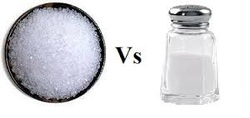
Sticking with the salt theme, have you noticed that sea salt seems to be showing up in chips and other snacks as well as grocery store shelves alongside good old iodized (table) salt? I’ve even started seeing sea salt in some restaurants. So, what’s the difference between sea salt and iodized salt, and is there any benefit to using sea salt over iodized salt?
Sea salt and iodized salt both have the same chemical composition, sodium chloride, and both types of salt contain the same amount of sodium. The differences between the two types of salt arise from the source and the level of processing of the salt.
The source of sea salt is evaporated seawater. If the sea salt is not refined, there will also be other trace minerals present in addition to sodium chloride. The trace minerals will impart color to the salt, typically pink, beige, gray, red, or black, depending on where the seawater comes from. Refining removes trace minerals, and refined salt is white.
The source of iodized salt is underground salt mines. The salt is typically white from being refined to remove trace minerals. Iodine is added to prevent goiter, an iodine-deficiency disease, and an additive is incorporated to prevent clumping so that the salt pours easily.
It’s worth noting that as long as manufacturers satisfy the FDA’s purity requirements, they do not have to reveal their sources, and “Sea salt” that is sold in markets might not come from the sea.
Some believe that sea salt tastes better than table salt. And even though there are claims that sea salt is a more natural and healthy alternative, according to the Mayo Clinic sea salt and table salt have the same basic nutritional value.
Sea salt and iodized salt both have the same chemical composition, sodium chloride, and both types of salt contain the same amount of sodium. The differences between the two types of salt arise from the source and the level of processing of the salt.
The source of sea salt is evaporated seawater. If the sea salt is not refined, there will also be other trace minerals present in addition to sodium chloride. The trace minerals will impart color to the salt, typically pink, beige, gray, red, or black, depending on where the seawater comes from. Refining removes trace minerals, and refined salt is white.
The source of iodized salt is underground salt mines. The salt is typically white from being refined to remove trace minerals. Iodine is added to prevent goiter, an iodine-deficiency disease, and an additive is incorporated to prevent clumping so that the salt pours easily.
It’s worth noting that as long as manufacturers satisfy the FDA’s purity requirements, they do not have to reveal their sources, and “Sea salt” that is sold in markets might not come from the sea.
Some believe that sea salt tastes better than table salt. And even though there are claims that sea salt is a more natural and healthy alternative, according to the Mayo Clinic sea salt and table salt have the same basic nutritional value.



 RSS Feed
RSS Feed